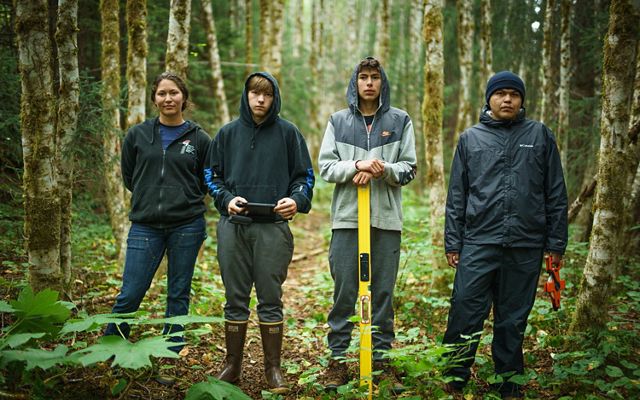The Canada lynx, nearly extinct in New Brunswick at one time, has moved from the endangered checklist to grow to be a species of concern, in accordance with the New Brunswick Species at Danger Act.
The federal government additionally made adjustments to the act just lately to higher replicate the kind of wolves as soon as discovered within the province.
Canada lynx, nonetheless, have rebounded and unfold out lately, though biologists are uncertain why.
“It was pretty considerable,” mentioned Graham Forbes, a wildlife ecologist professor on the College of New Brunswick who has hung out researching the species.
Over-trapping within the 1900s almost worn out lynx in New Brunswick.
“There have been bounties on them, for instance,” mentioned Forbes, who helped with the choice to maneuver the species off the endangered checklist.
He mentioned it is extraordinarily tough to get an correct inhabitants estimate, nevertheless it’s seemingly there are nonetheless fewer than 1,000 Canada lynx in New Brunswick.

The cats have been protected by the Species at Danger Act because the Seventies.
However regardless that they can’t be legally hunted in New Brunswick, they do find yourself in traps and snares meant for coyotes or bobcats. These carcasses should be handed over to the province, and lots of the information on the lynx inhabitants stems from that, Forbes mentioned.
“So the federal government has collected a knowledge set on lynx within the final 20 years, and it reveals that the inhabitants has elevated and unfold out from the place it had been, primarily within the Edmundston space,” mentioned Forbes.

Forbes mentioned proof warranted a change within the cat’s standing primarily based on the Canada-wide standards for species in danger.
“The sensation was that they’ve improved to the purpose the place they are not endangered, however there may be nonetheless a priority as a result of the inhabitants continues to be relatively low and there are nonetheless some threats towards it,” mentioned Forbes.
“There’s nonetheless sufficient points round that species that we don’t need to utterly take away it from the checklist and say it is not beneath menace.”
The brand new classification nonetheless retains them from being hunted or focused by trappers, he mentioned.
The inhabitants may develop past the necessity to give it protected standing, however lynx want deep snow to thrive, Forbes mentioned.
“When deep snow disappears, bobcats can transfer in they usually outcompete the lynx for meals and likewise bodily they’re fairly giant,” mentioned Forbes. “In order that’s a normal concern as New Brunswick is correct on the boundary between bobcat to the south and lynx to the north. We’re type of proper within the center.”
New Brunswick wolves
Within the 100 years since wolves roamed New Brunswick, scientists have debated in the event that they had been gray wolves or japanese wolves.
There are actually skulls or pelts to supply DNA for scientists to review, Forbes mentioned, and the province has been persuaded to switch the gray wolf on its checklist of domestically extinct species with the japanese wolf.
“We imagine that the canid that was current right here is one thing referred to as the japanese wolf, which is the species that was thought to happen, type of from Ontario, higher New York over in the direction of the Maritimes.”

Throughout Canada, the japanese wolf is taken into account a threatened species, and nonetheless is present in components of Ontario and Quebec. However in New Brunswick it’s labeled as extirpated, or domestically extinct.
Forbes mentioned they had been pushed out by over-hunting and bounties the province positioned on the animals to cut back their numbers.
As an alternative, japanese coyotes, a wolf-coyote hybrid, now roam New Brunswick, and just one wolf has been recorded in 100 years.
Tips on how to classify a species
The adjustments in classification for the wolf and lynx had been really helpful by a committee of biologists and ecologists. They utilized a regular used throughout Canada to find out which New Brunswick animals are endangered, extinct, or vulnerable to changing into endangered.
“We’ve got a set of standards we apply arms-length, objectively. We strive to verify it is primarily based on information,” mentioned Forbes, who is likely one of the voting members of the New Brunswick Committee on the Standing of Species at Danger, or COSSAR.
Three provincial officers assist however nobody from authorities has a say on how a species is assessed.
“No one from authorities votes,” mentioned Chris Norfolk, the director of the province’s forest planning and stewardship department and chair of the New Brunswick committee.
Forbes mentioned the committee evaluations organic research, observations, and quantitative standards on populations from researchers, scientists and information units. They then move their really helpful designations on to the minister of pure sources, who can settle for them or ask for extra data.
What do adjustments imply in sensible sense?
For wolves in New Brunswick, the change within the itemizing means nothing by way of conservation.
“There have not been a self-sustaining inhabitants of wolves in New Brunswick for a lot of, many, many many years, so actually this was simply an instance the place the science committee felt it was acceptable to alter the outline of the species to replicate some new proof.”
For the Canada lynx, the change would require crafting a provincial administration plan for the species.
“A administration plan primarily goes to take care of among the ongoing threats to the species and the way these threats can be managed over time,” mentioned Norfolk.


